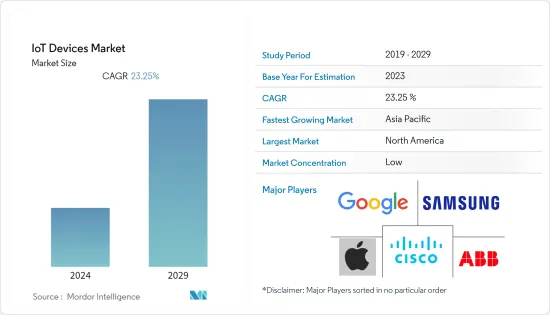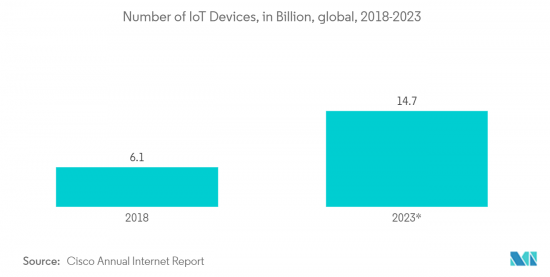PUBLISHER: Mordor Intelligence | PRODUCT CODE: 1406888

PUBLISHER: Mordor Intelligence | PRODUCT CODE: 1406888
IoT Devices - Market Share Analysis, Industry Trends & Statistics, Growth Forecasts 2024 - 2029

The IoT devices market was estimated at USD 98.06 billion in the current year. The market is expected to register a CAGR of 23.25%, reaching USD 336.64 billion in five years. IoT technology is the foundation for different enterprises to undergo a digital transformation, enabling them to improve current operations by developing and monitoring new business models. IoT has been viewed as the primary enabler in boosting digital transformation and uncovering operational efficiencies by businesses and service providers.
Key Highlights
- IoT devices might benefit more from data transmission speeds. IoT adoption and development are reliant on 5G as a trend. Predictive speeds of up to 10Gbps are possible with this technology. IoT networks' analysis and other capabilities will advance, along with the speed and accessibility of data exchange. 5G will revolutionize how IoT equipment operates and communicates with lower latency rates and more capacity.
- The growing trend of adopting connected devices in various sectors positively influences the market studied. According to Ericsson, the number of massive IoT connections is expected to have doubled, reaching nearly 200 million. According to Ericsson, by the end of 2027, 40% of cellular IoT connections will likely be broadband IoT, with 4G connecting most of them. However, with the introduction of 5G New Radio (NR) in the old and new spectrum, throughput data rates are expected to increase substantially for this segment.
- The Internet of Things (IoT) requires dependable connectivity and communications to establish proper data-sharing networks. Due to consumer demand, operators and developers have a wide selection of connectivity technologies.
- Open standards are critical enablers for the success of wireless communication technologies, such as RFID or GSM, and, in general, for any machine-to-machine communication (M2M). Without globally recognized standards, the expansion of RFID and M2M solutions to the Internet of Things (IoT) cannot reach a global scale. The need for faster setting of interoperable standards has been recognized as an essential factor for deploying IoT applications. It may hinder the usage of IoT devices if the implementation does not gain significant traction.
- IoT is significantly being utilized for monitoring patients' health status during the COVID-19 pandemic. For instance, in April 2020, SPHCC announced that it is using Bluetooth IoT products and solutions provider Cassia Network's gateways and VivaLNK's medical wearable sensors to monitor COVID-19 patients. Cassia's IoT Access Controller, a network management tool, is used by medical staff to monitor patients and provide a better real-time view of their vitals. Cassia's gateways allow almost 40 Bluetooth low-energy devices to be paired and connected simultaneously while giving the long-range connectivity required to cover several rooms in the SPHCC.
IoT Devices Market Trends
Medical IoT Application Segment is Expected to Hold Significant Market Share
- The market for connected medical devices is one of those new medical industries that has consistently grown over the last decade, given its dependency on IoT technologies. This feature brings it closer to Industry 4.0 paradigms. In the world of connected medical devices, opportunities for technological integration exist throughout the device's lifecycle, from manufacturing and maintenance to use. For over two decades, consumer-facing healthcare has steadfastly resisted the wave of innovations that have been disrupting industries. This means that the industry is ripe for disruption, and technologies like Artificial Intelligence (AI) and Machine Learning (ML) will be vital to unlocking greater connected healthcare possibilities.
- According to the US Centers for Disease and Prevention report, the overall life expectancy at birth is steadily increasing, with a target of 74.4 years by 2022, up from 73.3 years in 2017. Most of the increase is due to lower infant mortality. According to the same survey, life expectancy in the United States has dropped for the third year in a row to 78.6 years. People strive toward a healthy lifestyle to keep fit and monitor their eating habits. Such changes in people's behavior will increase the demand for connected medical devices.
- Moreover, due to inactive lifestyles, unhealthy diets, and obesity, some emerging and developed regions are witnessing a rising number of diabetic patients, encouraging market players to develop smart wearable medical devices. Beta Bionics developed a fully integrated medical wearable device that can autonomously manage blood sugar levels 24/7 for type 1 diabetes. Currently, it is in the state of clinical testing and unavailable for sale.
- Examples of IoMT applications include an electrocardiogram monitor that will detect irregular heartbeats or rates that are too low and diabetes devices such as smart insulin pens and glucose meters.
- Factors such as increased adoption of smart devices, rising demand for data analytics in the health sector, availability of smart devices at affordable pieces, and the market penetration of smart connected devices and wearables provide impetus to the market growth of Medical IoT devices. According to Cisco's Annual Internet Report, by the end of the current year, there will be close to 30 billion network-connected devices and connections, up from 18.4 billion in 2018. By 2023, IoT devices will make up 50% (14.7 billion) of all networked devices, up from 33% (6.1 billion) in 2018.
- On the flip side, factors such as the cost to implement IoT devices can be difficult, and health organizations' security concerns due to the implementation of IoT devices hinder the growth of medical IoT devices.

Asia Pacific is Expected to Hold Significant Market Share
- Asia Pacific has been an early adopter of technological advancements like AL and IoT. In these developing economies, the market poses a key advantage in implementing industrial automation since it is not tormented with rebuilding legacy automation systems and machine investments.
- Some critical factors for the widespread adoption include the Smart Nation initiatives driven by the governments of the various countries in the region and the current Industry 4.0 drive in the manufacturing and logistics sectors. Also, favorable infrastructures, such as high fiber connectivity, data centers, submarine cables, and operators' investments in low-power and 5G networks, are likely to drive the adoption of IoT further.
- Manufacturing serves as a significant industry in the Asia Pacific. As a significant contributor, the Chinese economy is undergoing a rapid transformation as labor costs have risen and the conventional model of migrant workers has lost sustainability. Such trends have pushed the economy to adopt automation as a part of manufacturing processes.
- IoT, being at the center of new technological approaches for development, production, and the entire logistics chain (otherwise known as smart factory automation), has further driven the adoption of industrial automation in the region.
- Moreover, the communications support for automated processes has facilitated easier adoption among manufacturers. Sensor components, faster networks, quality diagnostic software, and flexible interfaces with high levels of reliability and secured hierarchical access, along with error-correction options, have added productivity, continued quality deliveries, and minimized the cost of manufacturing in the region.
IoT Devices Industry Overview
The IoT devices market is highly fragmented. Some prominent players include Apple Inc., Google Inc. (Alphabet), and Samsung Electronics Co. Limited. Players in the market are adopting strategies such as partnerships, joint ventures, and acquisitions to enhance their product offerings and gain sustainable competitive advantage.
In November 2022, Samsung India unveiled its new Internet of Things (IoT)-enabled air purifiers. The new air purifier line contains two models, AX46 and AX32, with a one-button operation and guarantees to remove 99.97% of nano-sized particles, ultrafine dust, germs, and allergies. They also claim to easily remove potentially hazardous volatile organic compounds (VOCs), such as formaldehyde, ensuring that customers breathe clean air. Furthermore, Samsung announced SmartThings Home Life in August 2022, and the updated family hub links customers worldwide to an ecosystem of smarter living solutions that expand their home life experience.
In September 2022, Honeywell and Internet of Things Technologies Company (IoT-squared), a joint venture between Saudi Arabia's Public Investment Fund (PIF) and STC Group (STC), signed a Memorandum of Understanding (MoU) to advance the fields of logistics platforms, sustainable cities, and technologies which would drive the digitalization in Saudi Arabia. The strategic MoU supports the goals established in Saudi Vision 2030 for smart city development and expanding technology adoption in society.
Additional Benefits:
- The market estimate (ME) sheet in Excel format
- 3 months of analyst support
TABLE OF CONTENTS
1 INTRODUCTION
- 1.1 Study Assumptions and Market Definition
- 1.2 Scope of the Study
2 RESEARCH METHODOLOGY
3 EXECUTIVE SUMMARY
4 MARKET INSIGHTS
- 4.1 Market Overview
- 4.2 Industry Attractiveness - Porter's Five Forces Analysis
- 4.2.1 Bargaining Power of Suppliers
- 4.2.2 Bargaining Power of Buyers
- 4.2.3 Threat of New Entrants
- 4.2.4 Threat of Substitutes
- 4.2.5 Intensity of Competitive Rivalry
- 4.3 Industry Stakeholder Analysis
- 4.4 IoT Lifecycle Analysis
5 MARKET DYNAMICS
- 5.1 Market Drivers
- 5.1.1 Steady Growth in Demand for Connected/Smart IoT Devices in Key Segments
- 5.1.2 Software Innovations and Improvements in Connectivity Technologies to drive market growth (by Lowering Replacement Cycle)
- 5.2 Market Restraints
- 5.2.1 Lack of Standardization of Communication Protocol across Different Platforms
- 5.2.2 Issues Related to Security and Privacy of Data to Hinder the Adoption of IoT Devices
- 5.3 Industry Regulations - ISO/IEC JTC, ETSI, ITU, etc.
- 5.4 Pricing Analysis
6 TECHNOLOGY SNAPSHOT
- 6.1 Evolution of IoT
- 6.2 Analysis of Key Disruptive Technologies Expected to Aid Adoption
- 6.3 Analysis of Major IoT Components
7 MARKET SEGMENTATION
- 7.1 By Application Type
- 7.1.1 Connected and Smart Home
- 7.1.2 Medical IoT
- 7.1.3 Connected Car
- 7.1.4 Smart Cities
- 7.1.5 Industrial IoT
- 7.1.6 Personal IoT
- 7.1.7 Other Application Type
- 7.2 By Connectivity Type
- 7.2.1 WPAN
- 7.2.2 WLAN
- 7.2.3 LPWA
- 7.2.4 Cellular/M2M
- 7.2.5 Other Connectivity Type
- 7.3 By Geography
- 7.3.1 North America
- 7.3.2 Europe
- 7.3.3 Asia Pacific
- 7.3.4 Latin America
- 7.3.5 Middle East and Africa
8 COMPETITIVE LANDSCAPE
- 8.1 Company Profiles
- 8.1.1 Apple Inc.
- 8.1.2 ABB Limited
- 8.1.3 Cisco Systems Inc
- 8.1.4 Google Inc. (Alphabet)
- 8.1.5 Samsung Electronics Co. Limited
- 8.1.6 LG Electronics
- 8.1.7 Siemens AG
- 8.1.8 Honeywell International Inc.
- 8.1.9 Sony Corporation
- 8.1.10 Amazon.com, Inc.
- 8.1.11 Robert Bosch GMBH
9 INVESTMENT ANALYSIS
10 FUTURE OF THE MARKET




